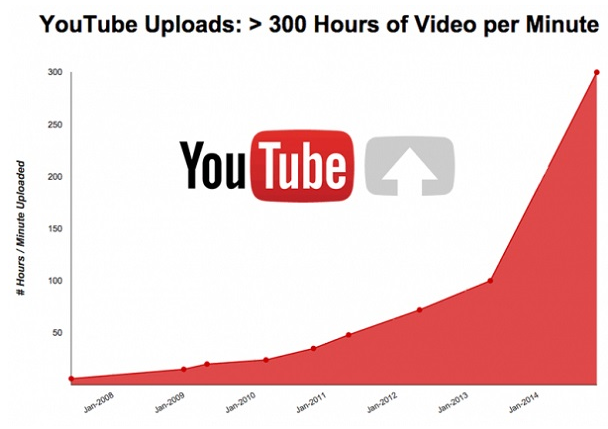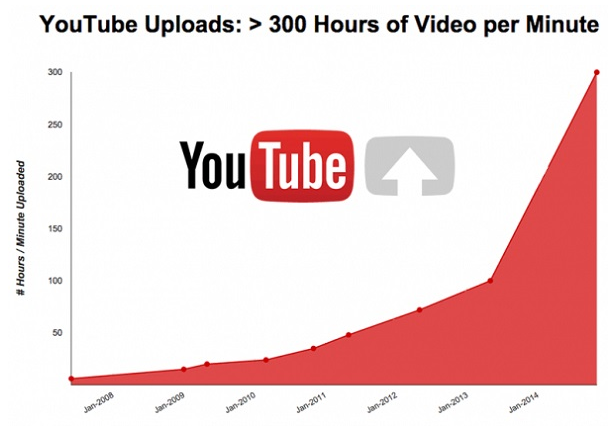
Technologists tell us that we are in the age of ubiquitous video. It seems that almost everything is being recorded. Naturally, this means that more and more video recordings are being introduced in court. A recent decision by the court of appeals is a helpful reminder of the two primary methods of authenticating video.
A word about ubiquitous video. Every year it is cheaper and easier to take, to store, and to share video recordings. The graph below illustrates the rate at which video footage is being uploaded to YouTube and so conveys some sense of magnitude of the ongoing explosion of video recording.
State v. Fleming. The rise of video was on full display in State v. Fleming, decided about three weeks ago. The case arose when two men worked together to steal purses from several department stores. One of the thefts was caught on the store’s surveillance video. An officer eventually located and interviewed one of the perpetrators, and that interview was also recorded on video. At trial, both videos were introduced. The court of appeals found that both were properly authenticated, though a different foundation was used for each video.
The interview: “fair and accurate.” Although it sounds like it could be the slogan for a television news program, “fair and accurate” is actually the most common foundation for admitting photographs and videos. A witness testifies that a photograph or a video fairly and accurately depicts what the witness saw, and says that the photograph or the video would help illustrate the witness’s testimony. For example, in Fleming, the officer testified that the video was a “fair and accurate depiction of the interview” of the defendant. That was sufficient to admit the video for illustrative purposes.
A couple of points to remember about this type of foundation:
- The witness doesn’t need to be the photographer or the videographer. See, e.g., State v. Gibson, 300 N.C. 741 (1980). As long as the witness saw the events depicted, he or she may establish the foundation by testifying that the photograph or the video fairly and accurately reflects the events.
- The photograph or video need not have been taken or produced at the time when the witness observed the scene. For example, a photograph that shows an intersection where an automobile crash took place may be a fair and accurate depiction of the intersection even if it was taken the week before, or the week after, the collision. See, e.g., id.
- This foundation allows the evidence to be admitted only for illustrative purposes only, not as substantive evidence. But that’s not too significant. The evidence may be published to the jury, and it appears that evidence admitted for illustrative purposes may be reviewed by the jury in the courtroom or in the jury room to the same extent as evidence admitted for substantive purposes. State v. Huffstetler, 312 N.C. 92 (1984) (finding that it was error, but not prejudicial, for the trial judge to allow the jury to review photographs in the jury room without the consent of both parties under G.S. 15A-1233(b), and stating that “[t]he photographs in question had been previously admitted into evidence and shown to the jury to illustrate the testimony of a law enforcement officer,” meaning that “the trial court had the discretion under [G.S.] 15A–123[3](a) to permit the jury to reexamine the pictures closely and at length in the courtroom”); State v. Cannon, 341 N.C. 79 (1995) (similar). The main drawback to introducing evidence only for illustrative purposes is that the party against whom the evidence is admitted is entitled to a jury instruction, upon request, to the effect that the evidence should be considered only for the purpose of illustrating the witness’s testimony. See, e.g., State v. Talbot, 234 N.C. App. 297 (2014); C.P.I. – Crim. 104.50 (pattern limiting instruction). I doubt that such an instruction is likely to make a major difference in how a jury views a photograph or a video.
The surveillance video: “functioning properly.” A second type of foundation that is frequently used with video recordings is the so-called silent witness foundation. It’s used when no witness is able to testify that he or she saw the events depicted, but a witness is able to say that the camera was functioning properly and that the video played at trial is the same one on that the camera recorded at the time in question. In such a case, the recording is admissible as substantive evidence.
In Fleming, that’s how the State introduced the store surveillance video. A “corporate investigator” working for a department store “testified the surveillance video system was functioning properly at the time the video was captured and the video images introduced at trial were unedited and were the same video images created by this system.” The court of appeals deemed that a sufficient foundation. Regular readers may remember that a similar foundation was used and approved in State v. Snead, a case I discussed here.
Concluding thoughts. With video becoming a common feature of criminal trials, it’s helpful for trial lawyers to have the basic foundation requirements for video at the ready, and this post summarized the two most common foundations: “fair and accurate” and “functioning properly.” It’s a video world out there, and the courts, like the rest of us, are just living in it.

